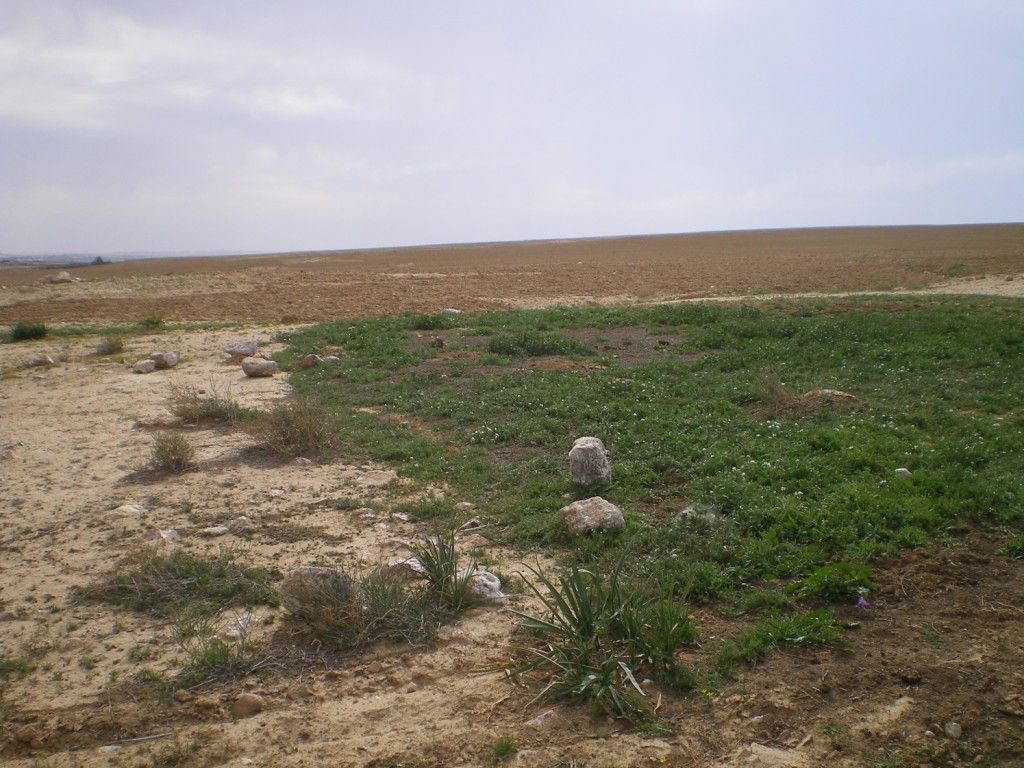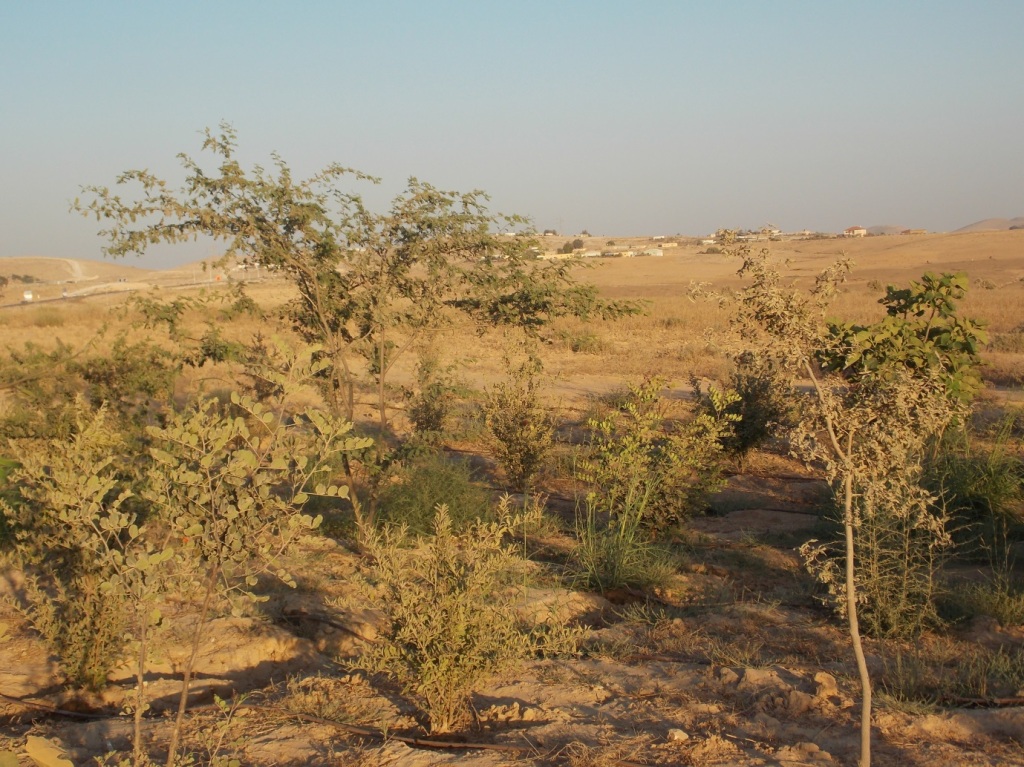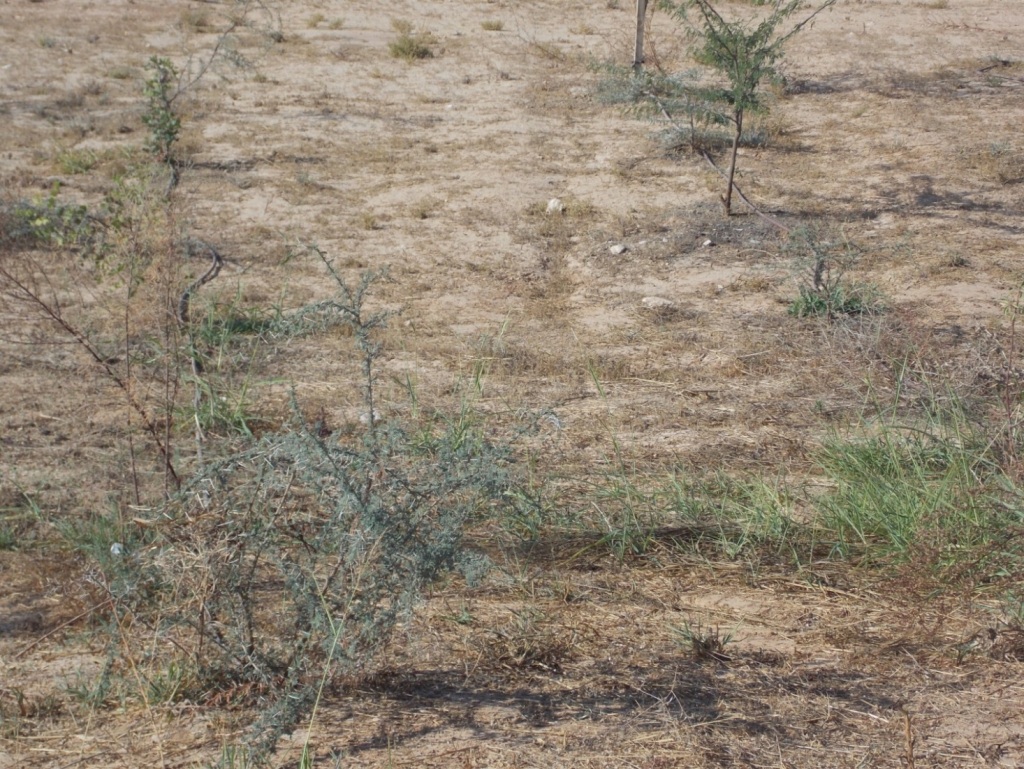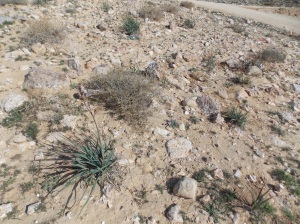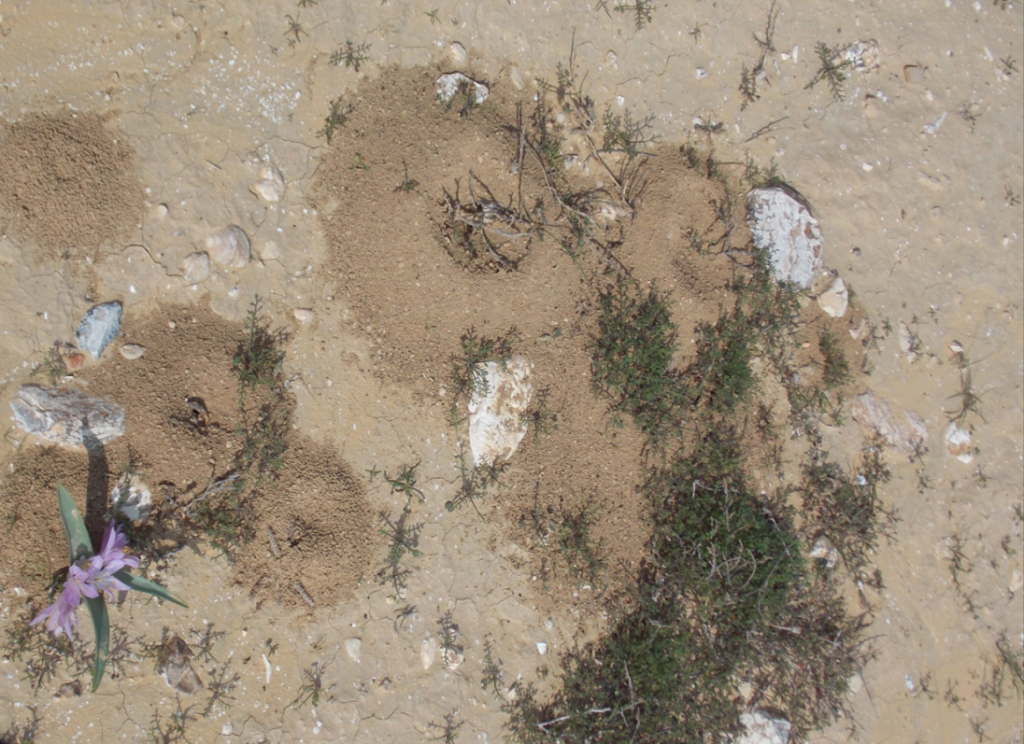Soil Rehabilitation
Section Summary
Soil fertility and soil-hydrology are the major determinants of biological productivity in drylands, and are therefore the key parameters for sustainable dryland management. Often, removal of vegetation is blamed for desertification, but actually, soil erosion and the degradation of soil quality resulting from reduced vegetation cover is the true cause for desertification. The true productivity potential of the Wadi Attir area is revealed in an area covered by ageing goat manure, where ten-fold productivity has been persistently maintained for many years, as compared to the surrounding exposed and degraded soil. Such exposed soils tend to crust extensively, promoting high surface water runoff and erosion. Therefore, maximal vegetation cover needs to be restored in degraded drylands in order to rehabilitate desertified ecosystems. Project Wadi Attir is demonstrating and addressing the challenges of effective and rapid soil and vegetation restoration by using a variety of approaches. Erosion gullies have been filled and terraces have been created and densely planted with a variety of nitrogen-fixing or otherwise beneficial dryland trees. Establishment of annual vegetation and shrubs is encouraged, and diverse, recovering vegetation has been protected from grazing in order to rapidly restore topsoil nutrients and soil organic matter, plant litter and soil organisms such as ants and beetles. Weeds are being chopped and left on the ground to provide a protective litter layer. This contributes to nutrient recycling, enhanced soil water infiltration, reduced evaporation and enhanced plant productivity for further-enhanced soil quality, a process carefully monitored and documented by accompanying research work.
…
Soil Degradation
Most of the world’s dryland soils are degraded and desertified, lacking vegetation cover, soil nutrients, and adequate biodiversity. Most of the Northern Negev is heavily degraded due to overgrazing, continuous soil tilling and misguided forestry approaches (Helman et al 2013). Figure 1 compares the phenomenology of degraded plots (upper two pictures) to that of restored and functioning dryland ecosystems recorded at the same date. The degraded plots have long-term biological productivity of about one ton per hectare per year, while the conserved plots produce over twice this amount. While plant biodiversity appears relatively consistent between the two plots, animal activity is significantly suppressed in the degraded areas (Leu et al 2014).




Fig 1: Conserved, highly diverse and productive shrublands and savannas (bottom two pictures) cover a tiny fraction of Israel’s Negev Desert. The remainder is profoundly degraded wasteland created by removal of trees and shrubs, overgrazing, tilling, contour trenching. These result in massive soil erosion and the loss of soil nutrients, soil organic carbon, and biological productivity (top two pictures). These four pictures, taken on the same date, demonstrate the state of productivity and biodiversity at two neighboring degraded locations and two conserved locations, each.
Rehabilitation of degraded drylands can restore essential ecosystem services such as biodiversity and sustainable supplies of fodder, food and renewable energy (Leu 2005; Abu Rabbia et al., 2008; Leu, 2010; Mussery et al., 2013), essential commodities in a world running out of quality water and farmland. Due to the significant increase in fodder production, restoration of degraded drylands and subsequent sustainable exploitation will provide clear and almost immediate economic benefits to the farmer, after relatively small investments (Leu and Mussery 2014). In addition, dryland rehabilitation by soil restoration or afforestation can contribute significantly to mitigation of global warming by sequestering carbon into soil and biomass (Grainger et al., 2000; Lal, 2001; Lal, 2004; Leu, 2010).
The State of Desertification at Project Wadi Attir
The 40-hectare site allocated to Project Wadi Attir has been subject to maximum levels of mismanagement for an unknown number of years, by repeated tilling and grazing without fertilizer inputs, fertility or grazing management. All woody plants had already been removed from the area, possibly thousands of years ago. Consequently, the area displays a profound loss of soil fertility and massive soil loss due to wind and water erosion. The erosion gullies pictured in Figure 2 gained in width and length by several meters just during the few years of project planning.
Fig. 2: The degraded loess soils at Project Wadi Attir have been subject to dramatic soil erosion. Even during the few years of the project planning phase, these erosion patterns grew by many meters in length and depth.


As demonstrated by thorough soil fertility analysis, all soil nutrients and soil organic matter are profoundly depleted. Consequently, biological productivity at the site was close to zero, and only a few annual species were able to thrive on the depleted site before project start.
The true rain-fed productivity potential of the site has been revealed by comparing biological productivity of average areas to a highly fertile soil patch created by a layer of livestock manure (Fig. 3). The manure-treated patch displays about 10 times higher productivity than the nearby control area. This phenomenon has been observed unchanged for the last six years, indicating that the impact of one time manure application results in permanent, long-term restoration of soil fertility.
Fig. 3: Maximal and ‘normal’ biological productivity at the Wadi Attir site. A former goat enclosure (the green vegetated patch in the picture) retains 10-fold higher productivity (“In,” in the on the right) for at least the last 6 years, compared to the surrounding bare control areas (“Out” in the same graph) that are almost depleted of vegetation, as seen in the picture to the left.
Soil Enhancement Approaches at Wadi Attir
The first step in the ecosystem restoration program was the remodeling of the topography in order to reduce water runoff and stop soil erosion. Massive soil erosion was stopped by filling erosion gullies and creating agroforestry terraces to curb destructive water runoff, while collecting water onsite for tree growth. Large numbers of trees were planted in the terraces and limans, both for agricultural use and for soil restoration, erosion control and windbreaks (Figure 4). The carefully selected mix of mostly native dryland tree species are expected to provide a wide range of services, many of them essential for soil conservation and improvement. These subjects are summarized in detail in the pages ‘Agroforestry and Permaculture’, and Water and Soil Conservation.


Fig. 4: Filling erosion gullies (bottom) and the subsequent establishment of agroforestry terraces (top) reduce water runoff as well as topsoil and nutrient loss. The planted trees enhance biological productivity, contribute to erosion control, and provide valuable tree litter for restoring soil fertility and microbial life.
Soil Restoration Principles at Wadi Attir
Rehabilitation of degraded dryland soils can be achieved by long term conservation, introduction of manure, application of fertilizer, seeds or tree planting, or a combination thereof, requiring varying time spans and financial resources. Extensive research at three different sites by the Wadi Attir scientific advisory team has contributed significantly to the development of the restoration technologies now applied. Overlaying manure (or compost) on exposed soil can provide the fastest possible level of persistent productivity restoration by providing seeds, nutrients, improved water infiltration, and increased microbial activity. Large amounts of manure are required, however, and therefore this approach will be demonstrated once the goat herd at Project Wadi Attir has been living for some time on the project site.
Fig. 5: Growth of annual weeds between planted trees is encouraged to provide shade and plant litter for soil improvement. Annual plant biomass (often called weeds) restores soil fertility by enhancing soil organic matter and biological nutrient fixation. Deep-rooted annual plants loosen the soil and are the fastest means to restoring soil organic matter. This is especially important within the limans and terraces, where standing water can lead to soil sealing and increased salinity.
Fig. 6: The large number of densely-planted trees aids in soil restoration by recovering nutrients such as phosphate, potassium and nitrogen from deeper soil layers, and depositing them as plant litter in the topsoil. The trees also act as windbreaks, and shade top soil to prevent excessive evaporation and high soil temperatures.
We aim to achieve the maximal speed of soil restoration without the application of fertilizers. The main objective is to restore biological productivity suited to the local climate by avoiding overgrazing and soil disturbances. Plants are able to accumulate and concentrate nutrients and carbon in the topsoil. Once the necessary amount of plant material is left onsite, a cycle of soil recovery is automatically induced, enhancing soil nutrient fixation and soil organic carbon accumulation with the help of an increase in soil microbial life. This, in turn, enhances soil water infiltration and further stimulation of biological productivity, ultimately reaching the maximal productivity possible with regards to available water resources. These principles are applied both in limans and other agroforestry plots (Figures 5 and 6). By leaving litter from the planted trees, together with chopped annual weed biomass, we have now created a significant layer of plant litter that will rapidly enhance soil water infiltration and fertility to maximal levels (Figure 7).
Fig. 7: Within one year, nitrogen-fixing trees such as the pictured acacia seedlings, together with chopped annual weed biomass, provided the plant litter that now protects the soil surface from the scorching sun, and allows zillions of soil animals and microorganisms to thrive and perform their essential task in soil improvement, enhancing soil organic matter and water infiltration, and fixing nitrogen and other essential nutrients into an intact below-ground soil ecosystem. This activity will ultimately restore the original biological productivity and resilience of the area.
Figure 8: Soil restoration by promoting growth of annual vegetation: Biological nutrient and carbon fixation induced by annual herbaceous vegetation and their root biomass will automatically enhance soil organic matter and soil nutrient pools in the future agricultural fields. The first wheat harvest at Project Wadi Attir (2014) was not consumed, but rather returned to the soil for recycling the seeds, and restoring soil organic matter and nutrients. The extent to which mild tilling affects this process is yet to be determined, though no-till agriculture appears to excel in this respect. Similarly, strategically placed woodland islands within the agricultural plots provide wind-breaks reducing wind erosion; those trees will also recover all nutrients leaching into deeper soil layers, thus preventing nutrient losses and groundwater pollution to essentially create a closed self-sustained system.
The same principles noted have been applied in the agricultural fields (Figure 8), where a first crop created by sowing wheat seeds was left standing in 2014, with all the biomass and seeds returned to the soil to induce an additional, similar cycle of soil rehabilitation. We expect to observe significant gains in productivity and soil quality in spring 2015ependent on average rainfall.
Restoration of Diverse Natural Biodiversity Reserves
Project Wadi Attir has reserved the most interesting onsite locations for conservation and the development of attractive biodiverse study sites. Currently, most of these areas are degraded, lacking shrub cover and biological productivity, and featuring poor soil quality and high water runoff. Conservation efforts and moderate grazing will restore these sites to healthy, diverse shrubland areas that can demonstrate the importance of dry shrubland ecosystems in soil conservation and erosion control, while maintaining and enhancing the already significant biodiversity of the rare and attractive desert flora.
Fig. 9: A classical, though degraded dry shrubland plot. Enhanced protection from grazing will restore the shrub-patch cover and annual plant productivity required to stop excessive water runoff while maintaining or enhancing plant and animal biodiversity.
Soil Improving Animal Activity
Special attention will be devoted to promoting and studying the development of animal activity within the recovering ecosystems. Animal activity, especially that of small and apparently “insignificant” creatures, is often insufficiently studied and appreciated. However, digging ground-dwellers, specifically, contribute significantly to restoring soil fertility and maintaining soil health by loosening soil structure, inserting and redistributing nutrients and organic matter, and altering and redistributing soil moisture and oxygen for enhanced soil microbial activity. Enhanced biological productivity is expected to induce significantly increased animal activity. To corroborate this hypothesis, we are currently studying the frequency and size of harvester ant nests (Figure 9), which appear to be the most suitable, observable bio-indicator for characterizing small animal activity.
Fig. 10: In spite of their tiny size, harvester ants’ joint efforts contribute significantly to nutrient recycling and soil organic carbon fixation in dry, degraded ecosystems. In addition, they enhance soil water infiltration and porosity, further facilitating, and profiting from, enhanced plant growth. The precise role of these fascinating engineers in dryland rehabilitation is a key focus of Project Wadi Attir’s associated research.
Fig. 11: The proverbially hardworking ant colonies collect large amounts of dry biomass that is being decomposed underground. Nutrient rich residues are deposited around the large nests to enhance nutrient and soil organic matter content. These residues often include excess collected seeds, resulting in the creation of fertility islands, affecting and improving soil and productivity.
Soil Enhancing Tree Species
As part of its agroforestry and silvipasture efforts, Project Wadi Attir is planting tree species confirmed to significantly improve soil quality, such as carob, Albizia lebbeck, Acacia sp, and Retama raetam. The leaf and seed litter of these trees rapidly restores topsoil fertility, as demonstrated in recent research work (Mussery et al 2013, Hellman et al 2014). Furthermore, such hardy tree seedlings are able to stop further soil erosion by stabilizing erosion gullies, as observed in Figure 12.
Fig. 12: The Australian shrub-tree Acacia victoriae has been identified in our recent research as the ideal soil restoration tool in arid parts of the Negev. Bare, exposed soil plots are sensitive to massive water runoff, causing gully formation and soil erosion. This highly drought-resistant, nitrogen-fixing tree can rapidly stabilize and restore such areas by massive leaf and seed litter production, stopping water runoff and evaporation while restoring soil fertility. This seedling was planted in Spring 2014 and managed to establish itself without further irrigation in a soil crack, stabilizing this erosion hotspot while restoring soil fertility.

